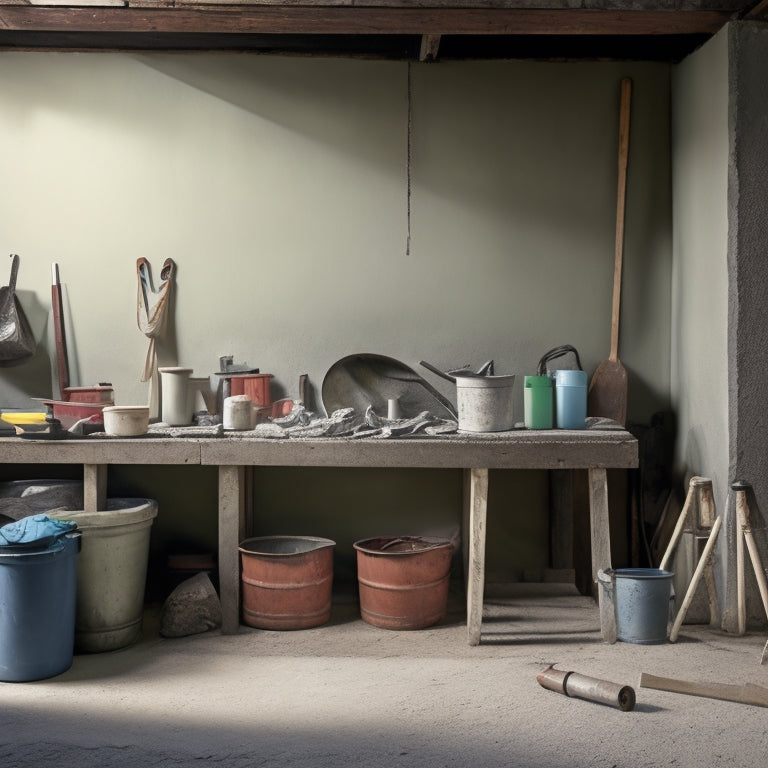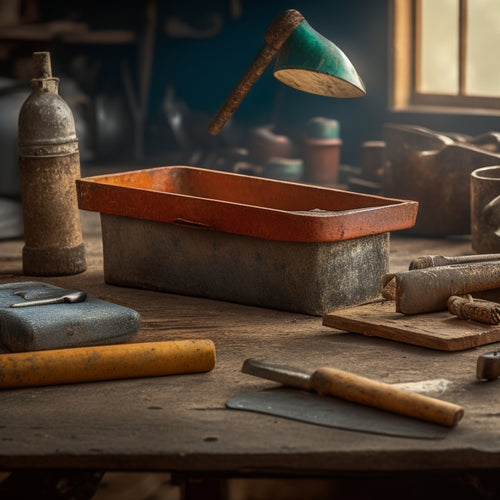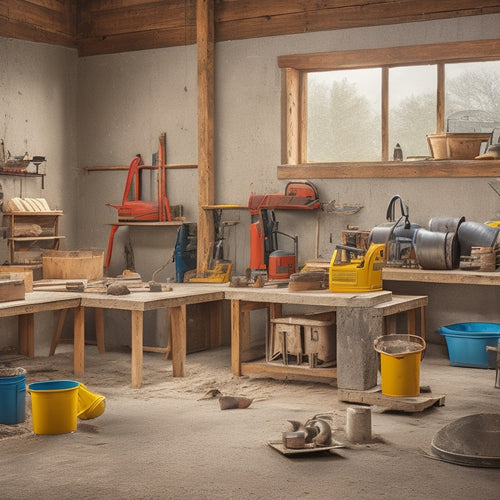
7 Best Concrete Mixing Tools for DIY Walls
Share
When it comes to DIY walls, you need the right concrete mixing tools to guarantee a successful outcome. You'll want essential drill bits like spiral mixer, mixing paddle, and spade bits for efficient mixing. A heavy-duty wheelbarrow and concrete mixer buckets with lids will help with transport and storage. Sturdy tamping tools and leveling screeds will come in handy for finishing. Mixing paddles for thick mixes and measuring boxes for accurate ratios are also vital. By investing in these 7 best concrete mixing tools, you'll be well on your way to achieving professional-looking results; now, explore each tool in-depth to master your DIY wall project.
Key Takeaways
• For DIY walls, use a spiral mixer bit or mixing paddle bit to break down aggregate and blend the concrete mixture thoroughly.
• A mixing paddle with a 45-degree angle is essential for thick mixes, ensuring uniform consistency and reducing fatigue.
• Invest in a heavy-duty wheelbarrow with a sturdy frame and robust tires for efficient transport of concrete.
• Use a concrete mixer bucket with a lid to ensure consistent texture and strength, and to reduce waste and improve organization.
• For a smooth finish, choose the right finishing tool, such as a bull float, hand tamper, or plate compactor, depending on the surface size and type.
Essential Drill Bits for Mixing
You'll need a set of reliable drill bits to effectively mix and blend concrete for your DIY wall project. When it comes to mixing concrete, the right drill bit types can make all the difference.
For a thorough mix, you'll require a combination of drill bits with varying shapes and sizes. Start with a spiral mixer bit to break down the aggregate, then switch to a mixing paddle bit to blend the mixture. A spade bit can also come in handy for scraping the sides and bottom of the mixing bucket.
To optimize your mixing technique, use a slow and steady pace to avoid introducing air pockets into the mixture. Begin by mixing the dry ingredients, then gradually add water while maintaining a consistent pace. As you mix, make certain the drill bit is fully submerged in the mixture to prevent splashing.
With the right drill bits and a well-executed mixing technique, you'll achieve a consistent, high-quality concrete mix that's perfect for your DIY wall project.
Heavy-Duty Wheelbarrow for Transport
Load up your heavy-duty wheelbarrow with the freshly mixed concrete, taking care to balance the load to prevent spills and messes during transport.
A well-designed wheelbarrow is essential for efficient concrete transport, and you'll want to choose one that can handle the weight and volume of your mix. Look for a wheelbarrow with a sturdy frame, robust tires, and a rust-resistant tray that can withstand the harsh conditions of concrete work.
When selecting a wheelbarrow, consider the wheelbarrow design and its impact on transport efficiency. A single-wheel design can provide better maneuverability, while a two-wheel design offers greater stability.
Additionally, a wheelbarrow with a large, flat tray can help you transport more concrete in a single trip, saving you time and energy.
Concrete Mixer Buckets With Lids
With your heavy-duty wheelbarrow loaded and ready to go, turn your attention to the concrete mixer buckets with lids, which will help you effectively mix and store your concrete mixture. These buckets are an essential part of the concrete mixing process, offering several benefits that will make your DIY wall project a success.
Here are four key advantages of using concrete mixer buckets with lids:
-
Efficient mixing: The bucket's design allows for thorough mixing of the concrete, ensuring a consistent texture and strength.
-
Easy storage: The lid keeps the mixture fresh and prevents it from drying out, allowing you to store it for later use.
-
Reduced waste: With a bucket size that's just right for your project, you'll minimize excess concrete and reduce waste.
- Improved organization: The bucket keeps your workspace organized and tidy, making it easier to focus on the task at hand.
Sturdy Tamping Tools for Finishing
Sturdy Tamping Tools for Finishing
Once your concrete mixture is poured into the DIY wall frame, sturdy tamping tools are essential for finishing the surface, guaranteeing it's even, compact, and free of air pockets. You'll need tools that can withstand the rigors of tamping and provide consistent results. When selecting a tamping tool, consider its durability and the tamping techniques you'll be using.
Here are some top-rated tamping tools for DIY walls:
| Tool Type | Material | Handle Length |
|---|---|---|
| Bull Float | Aluminum | 60 inches |
| Hand Tamper | Steel | 24 inches |
| Plate Compactor | Heavy-duty steel | 36 inches |
| Tamping Rod | Fiberglass | 48 inches |
When choosing a tamping tool, prioritize tool durability to ascertain it can withstand the demands of your project. Consider the material, handle length, and weight of the tool to guarantee it meets your needs. By investing in a sturdy tamping tool, you'll achieve a smooth, even finish and a structurally sound DIY wall.
Leveling Screeds for Smooth Finish
After achieving a compacted and even surface with your tamping tool, you'll need to confirm it's perfectly level and smooth, which is where leveling screeds come into play. These tools guarantee your concrete surface is free from imperfections, allowing you to achieve a professional-looking finish.
To get the most out of your leveling screed, it's important to understand the different screed types and leveling techniques. Here are a few key points to take into account:
-
Vibrating screeds use vibration to consolidate the concrete, resulting in a smooth, bubble-free finish.
-
Laser-guided screeds utilize laser technology to confirm accuracy and precision, making them ideal for large-scale projects.
-
Hand screeds are perfect for smaller projects and offer greater control over the leveling process.
- Power screeds are designed for high-volume concrete work and provide unparalleled efficiency and speed.
Mixing Paddles for Thick Mixes
When you're working with thick concrete mixes, using the right mixing paddle technique is essential.
You'll want to focus on three key points to guarantee a well-mixed batch:
-
Adjusting the paddle angle,
-
Mixing from the bottom up,
-
Scraping the sides of the mixing bucket clean.
Paddle Angle Matters Most
You'll get the best results with thick mixes by holding your mixing paddle at a 45-degree angle. This angle allows the blades to effectively scrape the sides and bottom of the mixing bucket.
This angle of attack guarantees that your paddle design is fine-tuned for mixing efficiency, allowing you to break down even the thickest of concrete mixes with ease.
Here are 4 reasons why paddle angle matters most:
-
Ideal Blade Engagement: A 45-degree angle guarantees that the blades are fully engaged with the mix, maximizing the mixing efficiency and reducing the risk of leaving unmixed pockets.
-
Effective Scraping: This angle allows the blades to scrape the sides and bottom of the bucket, preventing concrete from sticking to the surfaces and making it easier to mix.
-
Reduced Fatigue: By holding the paddle at the ideal angle, you'll reduce the physical effort required to mix the concrete, making the process less strenuous and more efficient.
- Consistent Results: A consistent paddle angle guarantees consistent results every time, which is critical when working with thick concrete mixes.
Mix From the Bottom
By starting from the bottom of the mixing bucket and working your way up, you guarantee that the mixing paddle captures all the dry ingredients and prevents them from getting stuck to the bottom or sides of the bucket.
This mixing technique, known as 'mix from the bottom,' is essential for achieving a uniform consistency in thick concrete mixes.
As you begin mixing, focus on creating bottom agitation by moving the paddle in a circular motion, ensuring all dry ingredients are incorporated. Gradually work your way up the bucket, maintaining a consistent pace to avoid creating air pockets.
This approach prevents segregation of the mix, which can lead to weak spots in your DIY wall. By mastering this technique, you'll be able to achieve a strong, durable, and long-lasting concrete structure.
Scrape the Sides Clean
As you've mastered the 'mix from the bottom' technique, now focus on scraping the sides clean with your mixing paddle to confirm all dry ingredients are fully incorporated, especially in thick mixes where stubborn particles tend to cling to the bucket's walls.
This significant step guarantees a uniform consistency and prevents weak spots in your DIY wall.
To perfect your cleaning techniques, remember:
-
Angled Scraping: Hold your paddle at a 45-degree angle to effectively scrape the sides and corners of the bucket.
-
Slow and Steady: Move your paddle in a slow, controlled motion to avoid creating air pockets and dislodging settled particles.
-
Residue Removal: Pay extra attention to areas where the mixing paddle tends to leave behind residue, confirming a thorough clean.
- Visual Inspection: Stop mixing and inspect the bucket's sides and corners for any remaining dry particles or residue, repeating the process until the mix is fully incorporated.
Measuring Boxes for Accurate Ratios
When you're mixing concrete for your DIY wall project, you know how essential it's to get the ratios just right.
You'll want to use a measuring box to guarantee you're combining the correct proportions of cement, sand, and aggregate.
Mixing Ratios Made Easy
You can simplify the process of achieving accurate mixing ratios by using measuring boxes specifically designed for this purpose.
These boxes take the guesswork out of mixing techniques, guaranteeing you get the perfect blend every time. With a measuring box, you can confidently calculate the ideal ratio of cement, sand, and aggregate for your DIY wall project.
Here are just a few benefits of using measuring boxes for accurate mixing ratios:
-
Consistency: Measuring boxes guarantee that every batch of concrete is mixed to the same ratio, resulting in a uniform finish.
-
Accuracy: Say goodbye to errors and miscalculations with a measuring box that guides you through the mixing process.
-
Efficiency: Measuring boxes save you time and effort by eliminating the need for ratio calculators and manual calculations.
- Professional results: By using a measuring box, you can achieve professional-looking results without the need for extensive training or experience.
Precise Measurement Matters
Precise Measurement Matters
By relying on measuring boxes to achieve precise measurement, DIYers can assure that their concrete mixture meets the exacting standards required for a strong, durable, and long-lasting wall structure. Accurate measurement is vital in concrete mixing, as it directly affects the final product's strength and quality. To guarantee precise measurement, it's important to choose a measuring box that's designed for the task.
| Measurement Technique | Tool Accuracy | Benefits |
|---|---|---|
| Volume measurement | ±1% | Ensures accurate ratio of cement to aggregate |
| Weight measurement | ±0.5% | Provides precise measurement for critical components |
| Multi-component measurement | ±2% | Allows for simultaneous measurement of multiple ingredients |
When selecting a measuring box, consider the type of measurement technique you need, the level of tool accuracy required, and the benefits each provides. By doing so, you'll be able to achieve precise measurement and assure a high-quality concrete mixture. Remember, precise measurement is key to achieving a strong and durable wall structure. With the right measuring box, you'll be able to master the art of concrete mixing and take your DIY projects to the next level.
Frequently Asked Questions
Can I Mix Concrete in a Plastic Bucket Without a Lid?
When you're considering mixing concrete in a plastic bucket without a lid, think twice.
While it's technically possible, it's not the most ideal setup.
The plastic durability of the bucket mightn't withstand the heavy mixing process, and you risk damaging the bucket or creating a mess.
You'll be better off using a sturdy, lid-equipped bucket specifically designed for bucket mixing to guarantee a smooth and efficient process.
How Often Should I Clean My Concrete Mixing Tools?
You're about to uncover a secret that'll make your concrete mixing game unstoppable!
Cleaning your tools regularly is essential, but how often is often enough? The answer lies in your mixing frequency.
If you're a DIY enthusiast mixing concrete daily, clean your tools after every use to prevent dried concrete buildup.
For occasional mixers, a weekly cleaning schedule should suffice.
Can I Use a Regular Drill for Mixing Concrete?
When it comes to mixing concrete, you're wondering if a regular drill will cut it.
The short answer is, it depends. If you're working with small batches, a drill with sufficient power (around 1,200 watts) might get the job done. However, its mixing efficiency will likely suffer, leading to an inconsistent mix.
For larger batches or more demanding projects, you'll want a dedicated concrete mixer that can handle the heavy workload and provide ideal mixing results.
Is It Necessary to Wear Gloves When Mixing Concrete?
When handling concrete, you're exposing yourself to harsh chemicals and abrasive particles.
It's essential you take safety precautions seriously, starting with skin protection.
You should always wear gloves when mixing concrete to prevent skin irritation, dryness, and even chemical burns.
Gloves will protect your hands from cement's alkaline properties, ensuring you can continue working without discomfort or injury.
Can I Use a Mixing Paddle With a Cordless Drill?
When tackling mixing tasks, you're likely wondering: can I use a mixing paddle with a cordless drill?
Absolutely, you can! This combo is ideal for efficient concrete mixing.
Familiarize yourself with various mixing techniques to get the most out of this pairing.
Choose from paddle types like spiral, helical, or mixing fins, each suited for specific mix consistencies.
Conclusion
You've made it to the final mix! With these 7 best concrete mixing tools, you're well-equipped to tackle your DIY wall project.
Did you know that the global concrete market is projected to reach $642.7 billion by 2025? That's a lot of mixing!
With the right tools, you'll be contributing to that staggering number in no time.
Now, get mixing and build that wall!
Related Posts
-

Smart Guide to Buying Used Concrete Hand Tools
You're about to buy used concrete hand tools, and you need to get it right. Dedicate time to identify the tools you n...
-

What Tools to Rent for a Concrete Home Reno
When tackling a concrete home renovation, you'll need to rent a variety of specialized tools to get the job done. For...
-

Top Mixing Tools for DIY Concrete Block Laying
When it comes to DIY concrete block laying, the right mixing tools are vital for a strong and durable structure. You'...


